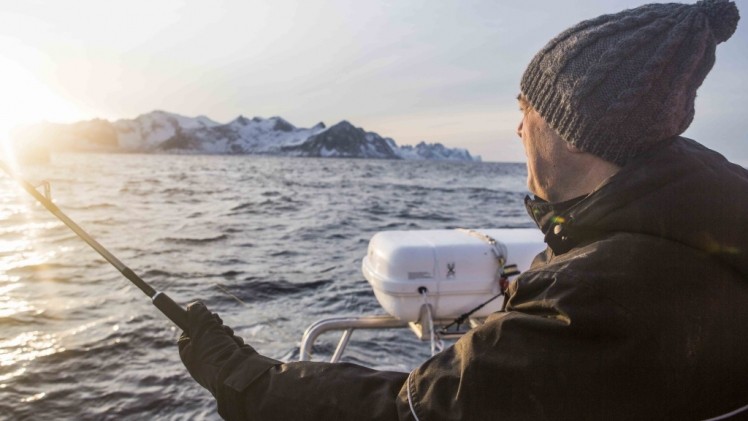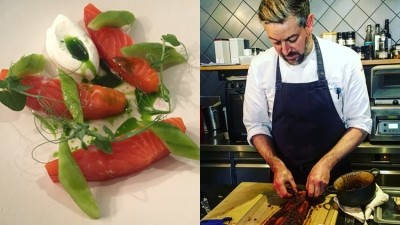Gone fishing: Restaurant's Norwegian pilgrimage to catch Skrei cod

There are many fresh ingredients eaten in the UK that are almost intrinsically linked with seasonality. No British chef worth their salt would, for example, put asparagus on their menu ahead of the homegrown season that starts around April. Likewise, you are unlikely to see strawberries on the menus of many British restaurants before summer is in full swing – except those places buying the Gariguette variety – thanks to growing consumer awareness of the English berry season.
And yet, when it comes to seafood, seasonality is often overlooked – with the exception of not serving native oysters unless there is an ‘r’ in the month – with chefs often more inclined to put sustainability at the forefront of their buying decisions and customers blissfully unaware that any such seasonality of the seas exists.
And yet it does. Moreover, it applies to one of the most popular fishes eaten in western Europe: cod. From January to April, Norwegian Skrei cod (pronounced ‘skray’) is in season, which is considered by Norwegians to be the king of the species and the perfect fish for restaurants wanting to serve the best-quality and seasonal cod available.
The wanderer Skrei cod are prized fish owing to a number of factors, not least the time spent in the nutrient rich Barents Sea and their 1,000km migratory journey back to their birthplace in the waters around northern Norway to spawn (Skrei comes from the Norse word ‘skrida’, which means to wander), which helps develop their muscles and characteristically firm texture.
But it is more than just the quality of the cod when it is alive that makes it such a precious commodity. To be labelled as Skrei, not only does the cod have to have been caught between January and April but it has to meet numerous stringent standards that ensure it reaches the user in the best possible condition.
Once caught, the Skrei has to be removed from the nets quickly so that it doesn’t drown or get damaged and then the fish must then be bled alive in running seawater. This process is designed to ensure that all the blood is drained from the fish, which gives Skrei its brilliant white colour. To ensure these standards are met, inspectors known as Skreipatruljen (Skrei policeman) make regular checks.
Skrei trippers
It’s one thing being told about the quality of Skrei but it’s another thing to experience the fish first hand. That’s why the Norwegian Seafood Council takes chefs on an annual pilgrimage to Sommarøy in northern Norway so they can try their hand at catching it as well as see it being processed.
This year’s expedition was once again led by Michel Roux Jr, an ambassador for Skrei in the UK, who was accompanied by chefs including Simon Hulstone from The Elephant in Torquay, Michael Wignall, who was until recently in charge of the kitchen at Gidleigh Park, Daniel Clifford, chef-patron at Midsummer House, Alyn Williams from Alyn Williams at The Westbury, Jose Pizarro from Pizarro Restaurants and Quo Vadis chef Jeremy Lee. And Restaurant went along to see how they got on.
As well as catching a number of Skrei in the icy waters around Sommarøy – props to Jose Pizarro for catching an absolute beauty – the chefs got to learn about (and taste) what Skrei has to offer. In Norway, the whole of the fish is used – from tongue to tail – such is its quality, and it is important that chefs get to experience its various parts, says Hans Frode Kielland Asmyhr, the country representative for the Norwegian Seafood Council in the UK.
Over lunch, we sit down to a meal that not only features loins of Skrei – served simply with boiled potatoes as is the traditional manner – but we also get to try the roe, which is cooked and then sliced, and the stomach, which was slow cooked to soften its texture. The liver, meanwhile, a staple in Norway thanks to its high levels of vitamin D that is crucial in the darker months, was also served, alongside flat bread and diced raw white onions.
“It’s an incredibly versatile fish,” says Roux Jr, who is a big fan of eating all parts of the fish, although he admits that the UK’s appetite doesn’t really extend beyond fish fillets.
“As chefs, we should be using more parts of the fish, and Skrei cod is an excellent example of why.”
The cod cheeks – which weren’t served as part of the meal on this occasion – are also a prized part of the fish. With a firm consistency, the cheeks are best baked, steamed or pan-fried and served alongside the fillet to showcase thedifferent textures of Skrei on a single plate. Indeed, the way Skrei cheeks are removed is symbolic of how important the fishing industry is to Norway across the generations. Children as young as 10 can be found on the processing plant floor deftly cutting out the tongues to earn some not insignificant spending money.
Seasonal and sustainable
So what’s the verdict among the other chefs? The Elephant’s Hulstone is a fan of Skrei, and puts it on the menu of his Torquay restaurant each winter because of the quality of the fish. Last month, he served fillet of Skrei with parsnip purée and a verjus and spring onion butter sauce at a guest chef event at J Sheekey in London, and the dish will appear on the menu at the Covent Garden restaurant until the middle of this month.
“Although not a local fish to us here in Torquay, sustainability is one of our key objectives as well as the use of seasonal produce,” says Hulstone. “Skrei sits in both camps but is also a very high-quality ingredient and consistent throughout its short season with a depth of flavour different to native cods and amazing pure white flakes of flesh.”
Quo Vadis’ Lee is also a fan.
“It’s is a joy being able to eat these beautiful fish, safe in the knowledge that it is fished in a wholesome manner with much care and respect,” he says.
“Our customers take their tuck very seriously. It is a vital part of the chef ’s role to source the best produce and to be aware and respectful of all ingredients, produce and producers.”
He also shares Hulstone’s view that seasonality is becoming an increasingly important factor when it comes to seafood.
“Seasonality and sustainability and quality are what customers expect and rightfully so. This, brilliantly, is now part of daily life.”
The last word goes to Williams, who admits to not knowing much about Skrei or cooking with it before the trip, but is now a convert. “The fish itself is like a thoroughbred… dynamic, athletic and superior eating to regular cod,” he says.
“Just simply boiled in salted water it was a revelation, [it is] so firm, tight and succulent. We will definitely be using Skrei on our menus in the future.”
What is Skrei?
Skrei is a type of cod that populates the Barents Sea before returning to its original spawning grounds off the coast of northern Norway between January and April each year. To be labelled as Skrei, not only must the cod have been caught during its spawning season, but it has to meet numerous standards regarding its killing, gutting, handling, packaging and storing that ensure it reaches the plate in the best possible condition. Once it has been caught, it must be removed from nets quickly so that it doesn’t drown or get damaged. It must then be bled alive in running seawater for around 30 minutes and subsequently kept in pre-cooled clean seawater. You can easily tell whether the cod that you have been supplied with is Skrei as whole fresh fish are required to bear the Skrei brand, which is fastened to its dorsal fin. The fish will also be brilliant white in colour, with a pearlescent flesh, owing to the way it has been bled.

































